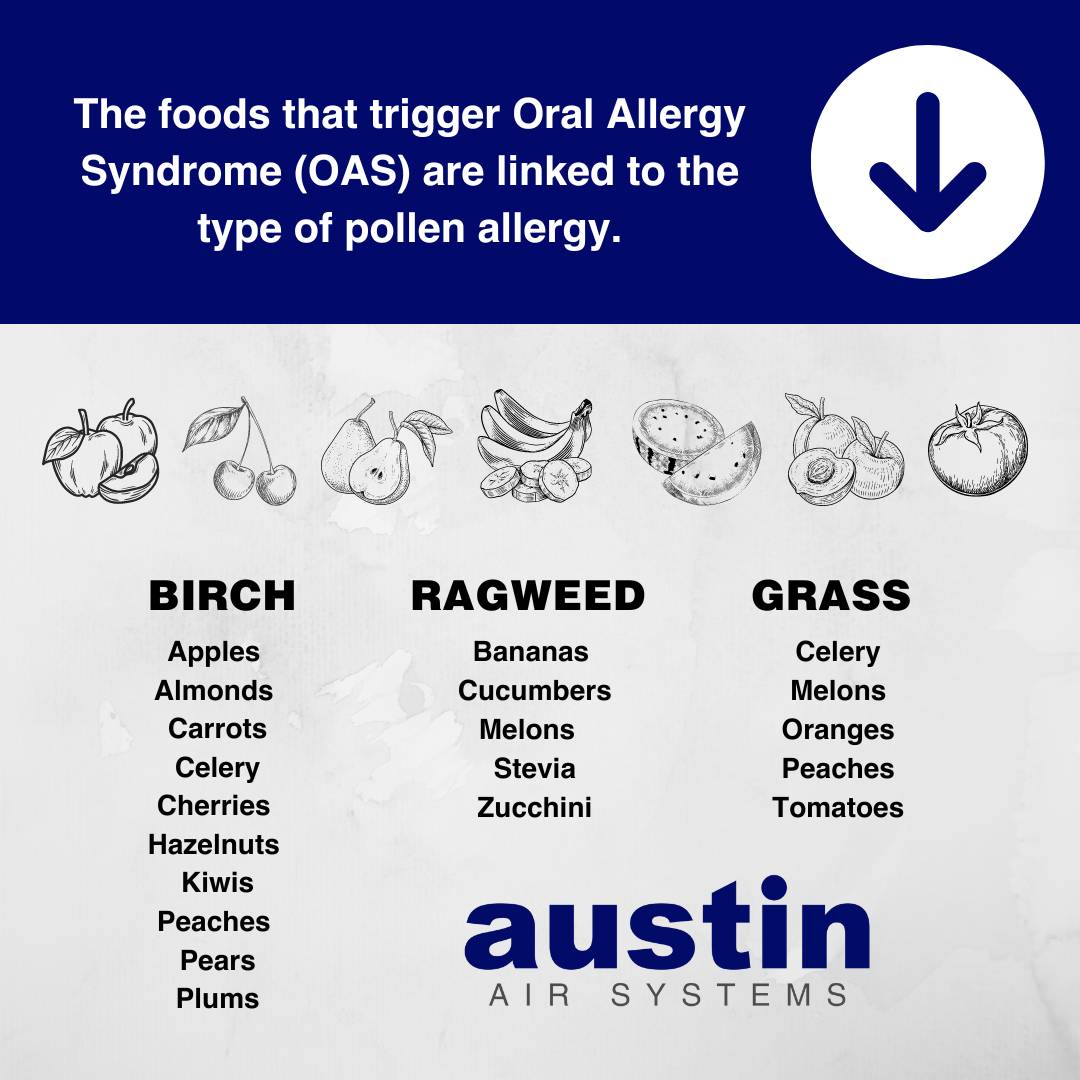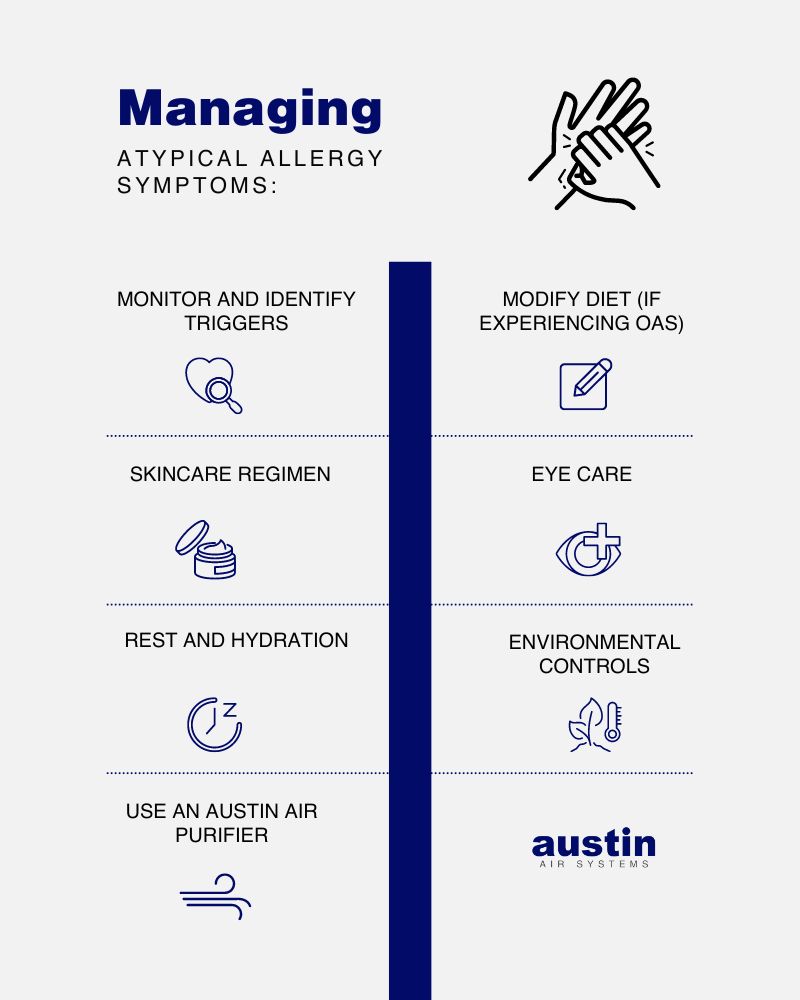When people think about allergies, they (reasonably) envision the hallmark symptoms like itchy eyes, a runny nose, and sneezing galore. However, allergies can manifest in a variety of less common and often surprising ways.
Understanding these atypical symptoms is crucial for those who suffer from allergies so you can possibly alleviate them, especially during the summer months when allergens like ragweed are rampant. Read on to learn about these atypical allergy symptoms, as well as some ways to prevent discomfort.
The Menace of Ragweed
Ragweed is one of the most notorious summer allergy triggers – usually ramping up in August and lasting about ten weeks. In other words, the worst of summer allergies is just around the corner. Ragweed pollen can travel for hundreds of miles on the wind, affecting individuals far from its original source. This pervasive pollen is lightweight and buoyant, easily spreading across regions and causing widespread allergic reactions.1
Oral Allergy Syndrome: The Hidden Connection
An intriguing aspect of allergies is the cross-reactivity between pollen and certain foods, a phenomenon known as Oral Allergy Syndrome (OAS) and also known as Pollen Food Allergy Syndrome (PFAS).2
OAS (or PFAS) is an allergic reaction that occurs in some individuals who have hay fever when they eat certain foods. It happens because their immune system confuses certain proteins in fresh fruits, vegetables, and nuts with pollen proteins, causing an allergic response. For example, those allergic to ragweed may react to bananas, melons, and zucchini, experiencing itching or swelling in the mouth and throat. The sugar substitute stevia is also a common trigger food.3
The leading symptoms include itching or swelling of the mouth, lips, tongue, and throat. Symptoms typically occur immediately after eating raw fruits or vegetables. In some cases, severe reactions can occur, though this is rare.
The foods that trigger OAS are linked to the type of pollen allergy you have.
Birch Pollen Allergy: Apples, almonds, carrots, celery, cherries, hazelnuts, kiwis, peaches, pears, and plums.
Ragweed Pollen Allergy: Bananas, cucumbers, melons (watermelon, cantaloupe, honeydew), stevia, and zucchini.
Grass Pollen Allergy: Celery, melons, oranges, peaches, and tomatoes.
If you have seasonal allergies and experience any discomfort after eating one of the above foods, you likely have OAS. Skin prick tests or blood tests may be used to confirm the specific pollen allergy.
OAS is generally mild and manageable with dietary adjustments and awareness of trigger foods. Management of OAS can be as simple as knowing and avoiding trigger foods, especially during high pollen seasons. Additionally, cooking the trigger foods often alters the proteins enough to prevent the allergic reaction. However, if you suspect OAS in yourself or your child, you should seek medical advice for proper diagnosis and management.
Ragweed Rash
Aside from respiratory symptoms, ragweed allergies can cause skin issues known as “ragweed rash.” Symptoms include red, itchy, and inflamed skin. Hives can also occur. In some severe cases, it can cause eczema-like symptoms, such as dry, scaly patches of skin.
Unfortunately, the causes – direct contact with ragweed pollen and airborne pollen settling on the skin – can be tough to avoid for anyone who needs to leave their house during high pollen counts.
The areas affected are usually exposed skin, such as the face, neck, arms, and legs. But ragweed rash can also affect other areas if pollen is spread by touching the skin or clothing.
Ragweed rash can be uncomfortable, but with proper management and preventive measures (outlined below), its impact can be minimized. If the rash is severe or persistent, it’s advisable to consult with a healthcare provider for personalized treatment and advice.
Atopic Dermatitis and Hay Fever: A Complicated Relationship
Ragweed rash isn’t the only possible skin condition caused or worsened by respiratory allergies. Atopic dermatitis, commonly known as eczema, isn’t caused by hay fever but can be exacerbated by it.4
This chronic skin condition, more prevalent in infants and young children, causes itchy, inflamed skin. During allergy season, those with hay fever may notice a worsening of their atopic dermatitis symptoms. This connection highlights the intricate ways in which different allergic conditions can interact and amplify each other.
Allergic Shiners and Puffiness
Another lesser-known symptom of hay fever is below-the-eye puffiness, which often accompanies allergic reactions. This puffiness can lead to the development of dark circles under the eyes, which have the charming nickname, “allergic shiners.”5
These symptoms occur because nasal congestion can impede blood flow near the sinuses, causing veins to darken and swell. The appearance of these dark circles can be mistaken for fatigue or lack of sleep, but they are actually indicators of an ongoing allergic response.
Fatigue and Headaches: The Silent Struggle
Fatigue is a common but frequently overlooked symptom of hay fever. The body’s ongoing fight against allergens can be draining, leading to a sense of constant tiredness. This fatigue can affect daily functioning and overall quality of life. Additionally, headaches are another symptom that allergy sufferers might experience. Sinus pressure and congestion can trigger headaches, which are often mistaken for tension or stress-related headaches.
Managing Atypical Allergy Symptoms
Recognizing these atypical symptoms is the first step in managing them effectively. Here are some strategies to help mitigate the impact of these lesser-known allergy symptoms:
Monitor and Identify Triggers: Keep track of when symptoms occur and try to identify potential triggers. This can help in avoiding specific allergens or taking preemptive measures when exposure is likely.
Modify Diet: For those experiencing OAS, cooking vegetables and fruits can often reduce the allergenic proteins and prevent reactions. Avoiding raw forms of these foods during peak allergy seasons can also help.
Skincare Regimen: For those with atopic dermatitis, maintaining a consistent skincare routine with moisturizers and avoiding irritants can help manage flare-ups. Consulting a dermatologist for personalized care is also beneficial.
Eye Care: Using cold compresses and antihistamine eye drops can help alleviate below-the-eye puffiness and reduce the appearance of allergic shiners.
Rest and Hydration: Ensuring adequate rest and staying hydrated can help combat fatigue. Over-the-counter allergy medications or prescribed treatments can also alleviate symptoms and improve energy levels.
Environmental Controls: Reducing exposure to allergens by keeping windows closed during high pollen counts and regularly cleaning living spaces can help minimize symptoms.
Use an Austin Air Purifier: Using an Austin Air cleaner will help to reduce your exposure to allergens in the home or workplace. All of our units have been designed to filter out pollen and other airborne allergens.
**************************
While itchy eyes and runny noses are the most recognized symptoms of allergies, it’s essential to be aware of the atypical ways in which allergies can manifest. From the widespread impact of ragweed pollen to the unexpected connections with certain foods, allergies can affect individuals in diverse and sometimes surprising ways. Recognizing and addressing these atypical symptoms can lead to better management and improved quality of life for allergy sufferers. By staying informed and proactive, one can navigate the challenges of allergy season more effectively and comfortably.
And of course, adding an Austin Air purifier to your anti-allergen arsenal will help you breathe easier throughout allergy season and beyond.
REFERENCES
1 Ragweed Allergies. (2020 October 28). Allergy & Asthma Network. https://allergyasthmanetwork.org/allergies/pollen-allergy/ragweed-allergy/.
2 Oral Allergy Syndrome Symptoms, Diagnosis & Treatment (2024 January 10). American Academy of Allergy, Asthma, and Immunology. https://www.aaaai.org/tools-for-the-public/conditions-library/allergies/oral-allergy-syndrome-(oas).
3 Urban JD, Carakostas MC, & Taylor, S. L. (2014 November 18). Steviol glycoside safety: Are highly purified steviol glycoside sweeteners food allergens? Food and Chemical Toxicology, 75, 71–78. doi: 10.1016/j.fct.2014.11.011.
4 Atopic Dermatitis. (2024 June 21). National Institute of Arthritis and Musculoskeletal and Skin Diseases. https://www.niams.nih.gov/health-topics/atopic-dermatitis.
5 Allergic Shiners. (2023 October 17.). Cleveland Clinic. https://my.clevelandclinic.org/health/diseases/allergic-shiners.


